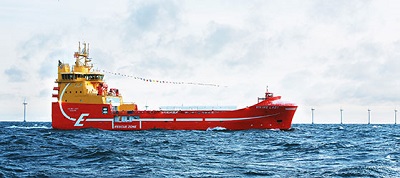First Battery Retrofit for OSV
Norwegian offshore support vessel operator Eidesvik is installing a batter system on board its supply vessel Viking Queen. This will be the first offshore vessel to get such system installed as a retrofit solution and demonstrates that it is possible to achieve significant reduction in emissions for existing vessels.
The LNG fuelled Viking Queen is a 6,000 ton vessel built in 2008. Its new energy storage system will have a capacity of 650kWH and can supply up to 1600kW. The solution gives a fuel saving of approximately 18 percent for the vessel. Further, NOx and CO2 emission levels will be reduced by approximately 25 percent.
The project is the result of cooperation between Lundin Norway who has the vessel on hire, ZEM as supplier of the system and Eidesvik. Commercialization of the technology has been made possible largely because Eidesvik participated in the research and development project FellowSHIP that has worked with battery technology for five years.
“We are very happy now to further develop the cooperation with Lundin Norway - a company that once again is willing to commit to solutions that are more environmentally friendly.” says CEO of Eidesvik, Jan Fredrik Meling. “In a time where our line of business is facing significant challenges, we are also happy to see that together we are able to find solutions giving cost reductions and profitability to all parties involved, and also significant environmental gains.”
 Viking Lady
Viking Lady
Eidesvik pioneered battery technology with its offshore supply vessel Viking Lady. The vessel’s fuel cell, battery hybrid installation gives a 15 per cent reduction in fuel consumption, 25 per cent reduction in NOx emissions and 30 per cent reduction in GHG emissions.

that matters most
Get the latest maritime news delivered to your inbox daily.
These reductions can be realized in practice, especially for dynamic positioning operations. The Viking Lady uses a conventional diesel-electric propulsion system, comprising four dual-fuel engines driving five thrusters for propulsion and maneuvering and dynamic positioning. The vessel’s lithium-ion battery has a capacity of 450 kWh – enabling the vessel to use hybrid-electric propulsion. The battery acts as an energy buffer that is able to cover the intense load variations that can occur, especially in dynamic positioning and standby operations.
This system results from a FellowSHIP research and development project between DNV GL, Eidesvik and Wärtsilä, co-funded by the Research Council of Norway.
